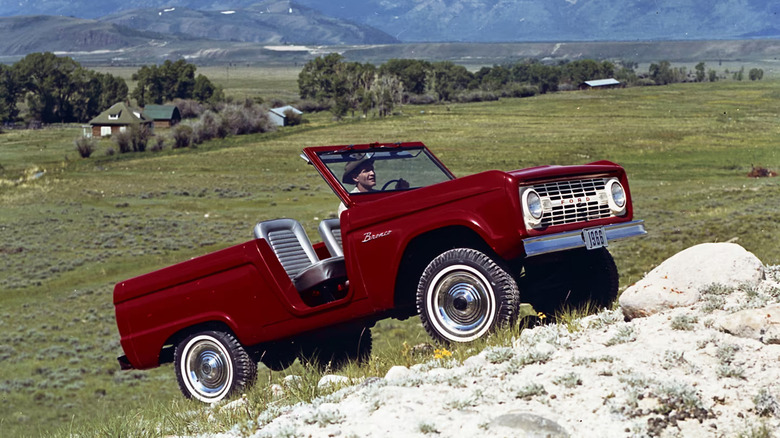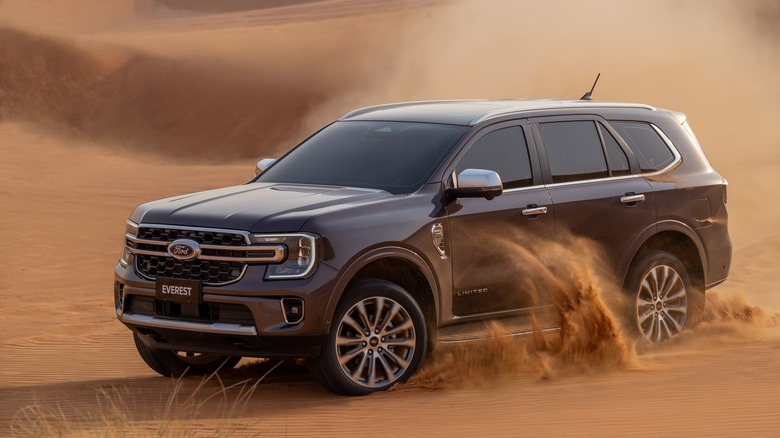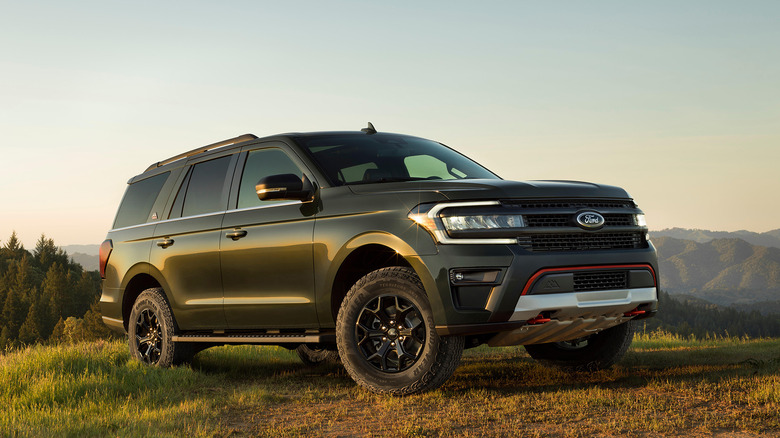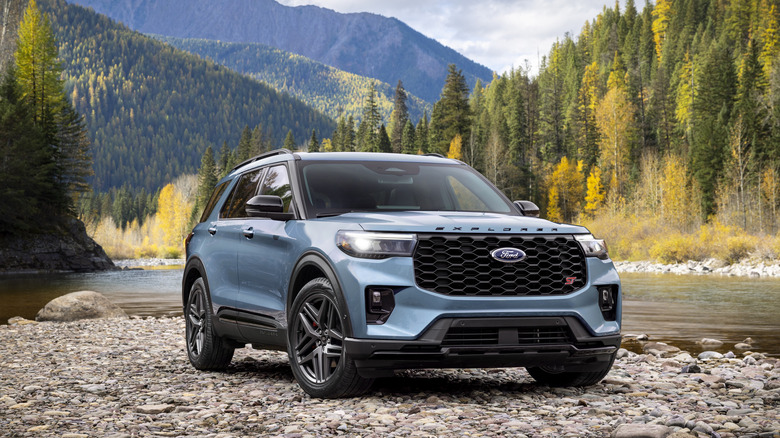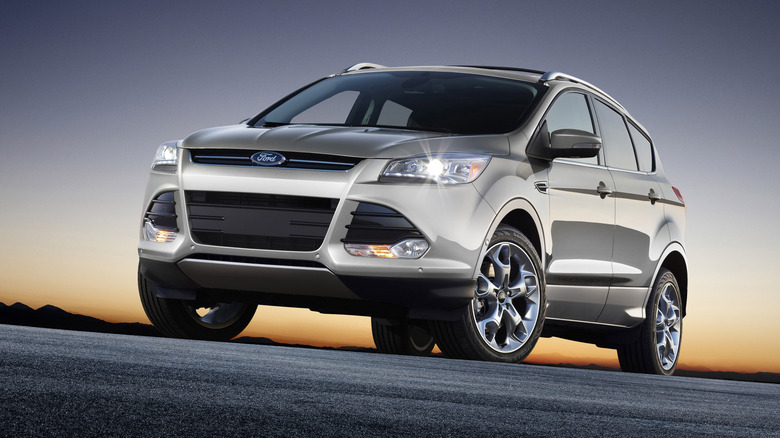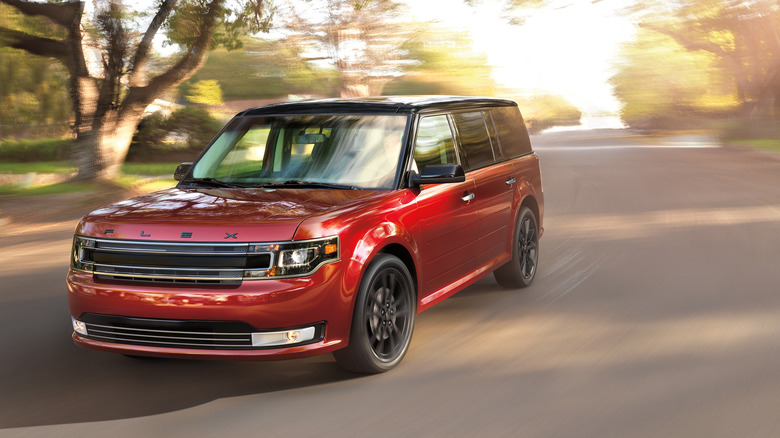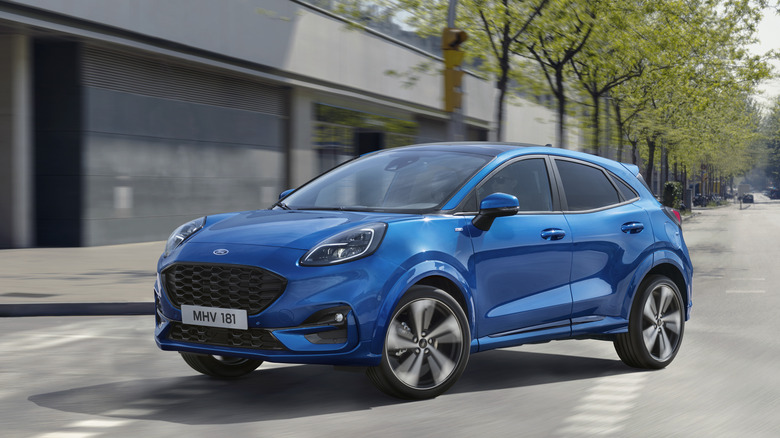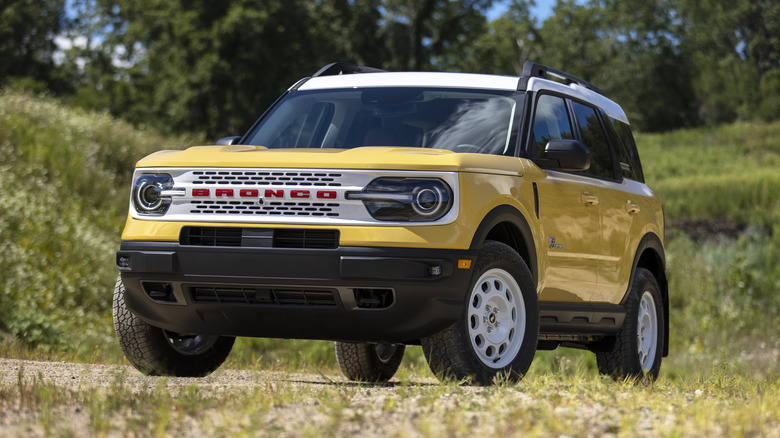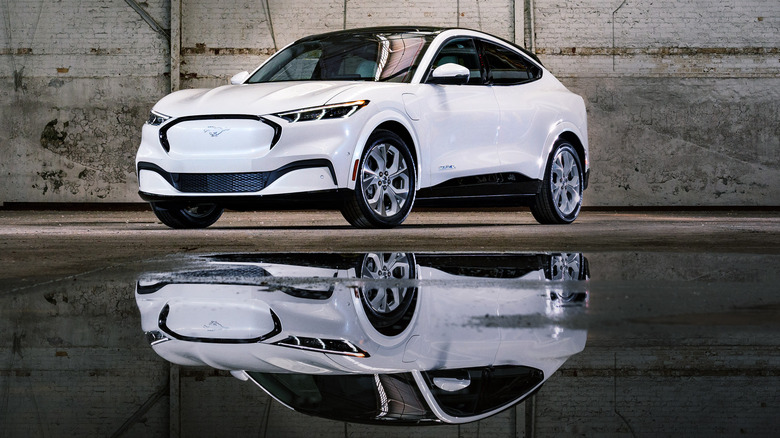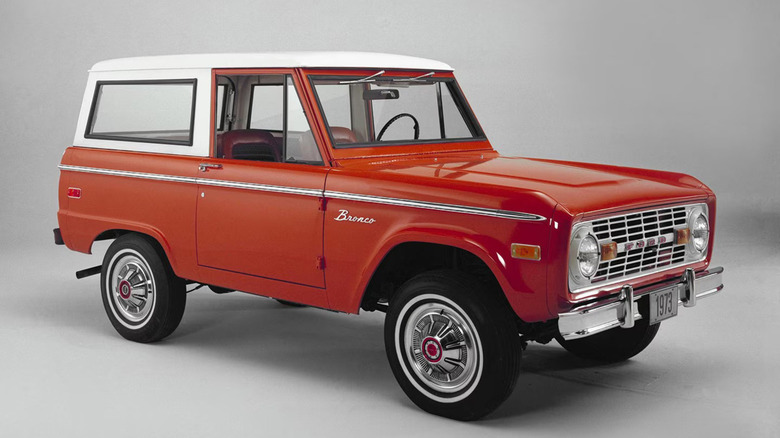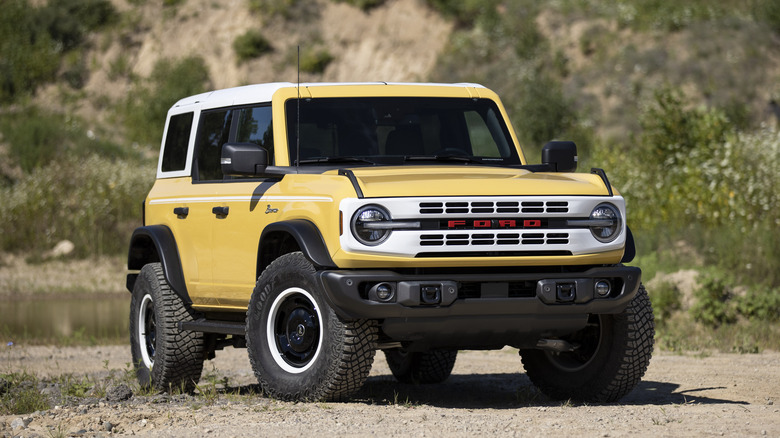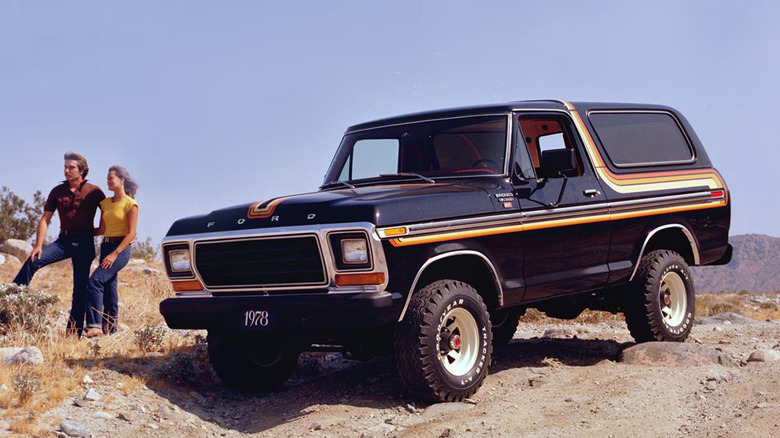11 Of The Best Looking Ford SUVs Ever Designed
Henry Ford is one of the most influential people in automotive industry. The fact that cars are so attainable today can be attributed to his introduction of the moving assembly line, which dramatically reduced production time and cost. However, Ford is also infamous for saying "customers can have any color as long as it is black." This might seem like a huge limitation, but it launched the Ford Motor Company into the stratosphere regarding sales, with its Model T becoming the best-selling car of its era.
And despite Mr. Ford's edict, the company even moved the visual side of automotive design forward with models like the Mustang and the GT. Ford's never lacked attractive SUVs in its lineup as well. Ever since the first Bronco, it's excelled at producing capable models that still looked cool. In fact, today, most of Ford's lineup consists of crossovers or SUVs, with unique offerings for every type of buyer. But which high-riding models are the most handsome?
That's the burning question we'll try to answer today after laboriously staring at pictures of every SUV the American automaker has ever produced. Obviously, the list is subjective because emotions are necessary when design is concerned, but we've ordered this from worst to best (not that any of these are bad). Have fun, and feel free to disagree!
Ford Everest (2022 to Present)
Ford's trucks and SUVs on sale in North America are quite different from one another, though generally you can still see a little family resemblance. In other markets, though, Ford's off-road-focused SUV and truck offerings are very similar. One of the coolest Ford models you can't buy in America, the Everest is an SUV version of the Ranger pickup. As such, it's as heavy-duty as the Bronco, with off-road abilities that far surpass Ford's three-row family SUVs sold in North America.
The Everest also looks the part, with a rugged yet modern style that catches the eye. The front end is almost a carbon copy of the Ranger, save for some differences in the bumper design, and leaves quite a macho impression. The C-shaped headlights connected with a chromed bar add some contemporary flair, while the medium-sized grille is nicely integrated into the body. From the side, the Everest is less interesting, though careful body surfacing gives it a chunkier look. Meanwhile, the back end features sleek LED taillights with an Everest logotype in the middle.
The best part about the new Everest is its two excellent diesel engines. The 2.0-liter Bi-Turbo diesel produces 207 hp and 369 lb-ft of torque while sipping fuel at an outstanding 33 mpg. Meanwhile, the 3.0-liter V6 turbodiesel makes 247 hp and a massive 443 lb-ft of torque, with a fuel consumption of only 28 mpg. Makes you wonder why we ever ditched turbodiesels in North America!
Ford Expedition facelift (2022 to Present)
Minivans were once the go-to choice for families in North America. Today, though, they are deemed uncool and were replaced by much larger three-row SUVs. Looking at the facelifted Ford Expedition, introduced in 2021, the move seems justified. Ford's largest SUV is more off-road capable than ever before, thanks to the added Timberline trim, while also bringing advanced tech to the table. And while it certainly won't contribute to less cluttered streets, it is one of the sleekest-looking SUVs in its class and certainly cooler than any minivan.
What sets the Expedition apart from its rivals is that it hides its size well. Notably, its black grille is not as massive and forms a coherent whole with the C-shaped headlights. The side profile is very minimalist, with a sharp incision below the window line that connects the headlights and taillights, giving the SUV a more elegant appearance. The rear end looks more sedate, but it's at least not flashy or too intimidating. Overall, its harmonious design oozes sophistication, with the Timberline model adding some ruggedness to the table.
The Expedition is also technologically sophisticated. It's powered by a 3.5-liter twin-turbo V6 that produces up to 440 hp and 510 lb-ft of torque, making it quite sprightly off the line. Despite that, it delivers 16 mpg city and 22 mpg highway for the all-wheel-drive models, which are good economy figures for a large three-row SUV.
Ford Explorer ST sixth-gen facelift (2025)
The Explorer was once a body-on-frame family hauler with off-road characteristics, but it's had a unibody car platform since 2011, and become more focused on delivering refined on-road characteristics than all-terrain capability. In our first drive of the latest 2025 ST variant we thought it was a great-handling mid-size SUV — kind of like if a hippo took ballet lessons. The Explorer ST is quick, too, with its 400-hp 3.0-liter EcoBoost V6 propelling it to 60 mph in just 5.3 seconds, thanks in no small part to the 10-speed transmission.
The Explorer ST's excellent dynamic abilities are accompanied by a very sharp, sporty design. It's a breath of fresh air in the category full of much more sedate rivals. Up front, Ford's mid-size SUV has a huge black grille, which somehow doesn't look out of place, probably thanks to the cool honeycomb pattern. The headlights are nicely integrated and look like the grille's wings, while the bumper design around the fog lights accentuates them even further.
The side profile is quite dynamic, thanks to the deep incision that connects the front wheel arches with the taillights. Meanwhile, the rear end features two pairs of exhaust tips and prominent sporty boomerang-shaped LED taillights. The most enjoyable aspect of Explorer ST's body design is that every accent is black, with only the exhaust tips finished in chrome.
Ford Escape third-gen pre-facelift (2013 to 2016)
The third-gen Ford Escape, also known as Kuga in Europe, remains one of the most dynamic-looking compact SUVs ever sold on U.S. soil. It comes from an era when mammoth grilles weren't a determining factor in how sporty an SUV was; instead, they used energetic and keen body shapes. The slanted windshield and bonnet, the dynamic incision line in the side profile, and the sharp front headlights all point forward, making it like the Escape is moving even when standing still.
Ford's designers also focused on making the sheet metal more interesting. As such, two dynamic lines on the hood accentuate the blue oval, accompanied by two lines that form the grille and then continue over the headlights. These give off an interesting, 3D look, showing the care Ford took when designing this crossover SUV. The rear end is also very interesting. It features huge taillights that start from the sides, a raised line that connects them, a rear window with a trapezoidal shape, and two fairly large exhaust tips.
Unfortunately, Ford decided to follow the rest of the industry with the refreshed 2017 Ford Escape and slapped a huge chrome grille on its face. Not only that, but the facelifted model didn't have the interesting 3D surfaces of the original — it still looked good, but definitely not as unique, with a front end looking similar to the Ford Edge.
Ford Flex facelift (2013 to 2019)
Ford Flex's styling is not to everyone's liking, but you can't deny its distinctiveness. Its boxy body is reminiscent of station wagons from the 1970s, giving it a unique, retro vibe. Even so, the Flex managed to look fresh and modern, even five years after being discontinued. That is particularly true for the facelifted model announced for the 2013 model year, which looks way sharper. Crucially, the rectangular shape opens up quite a lot of space inside the cabin in all three rows. The fact that the suspension is smooth yet dynamic and the available 365-hp 3.5-liter twin-turbo EcoBoost V6 is plenty powerful make the Ford Flex a true road trip king.
You will radiate the "cool family" vibe on every scenic drive in this car. The straight lines and sharp angles are different from any other SUV on the road, with the slab-like proportions giving a planted look. Still, Ford's designers weren't lazy and made sure every detail worked. Upfront, the grille is short and wide and connects seamlessly to the C-shaped headlights, accentuating the Flex's wide stance. The four grooves in the doors give a retro vibe, while the huge glass area emphasizes practicality and cabin space. Meanwhile, at the back, the black insert between the taillights is reminiscent of the front fascia, leading to a more coherent overall look.
Ford Puma (2019 to Present)
The first-gen Ford Puma was one of the most popular cars among younger drivers in Europe. It was cheap, thanks to its Fiesta underpinnings, and very fun to drive. Crucially, though, it was one of the most attractive vehicles on the road, with Ford's New Edge styling working quite brilliantly on the diminutive coupe body. So, there was quite the excitement when rumors flew around about a successor to the Puma. Unfortunately, like with most cool nameplate revivals (looking at you, Mitsubishi Eclipse Cross and Ford Capri), the second-gen Puma was an urban crossover SUV — but don't dismiss it out of hand.
The newer Puma is one of the coolest-looking crossover SUVs currently on sale in Europe. Sure, it doesn't have the funky proportions of the original, but for the type of vehicle the Puma is, it looks very attractive. The SUV's body seems sculpted by hand, with fluid features and almost no geometric shapes or straight lines. It's often easy to mess up organic designs in cars, but Ford did a stellar job with the Puma.
Where is the fun? Ford has you covered on that front as well! The new Puma is one of the most entertaining crossover-SUVs on sale in Europe, with excellent driving dynamics. There is even an ST variant with a 197-hp 1.5-liter three-cylinder turbocharged engine. It sprints to 62 mph in just 6.7 seconds and is even more fun to drive.
Ford Bronco Sport (2021 to Present)
The Bronco revival, launched in 2020, was welcomed with open arms by off-road enthusiasts. Alongside the rugged body-on-frame SUV, Ford also launched the Bronco Sport — a milder alternative designed to appeal to buyers who are more into the retro design than the true off-road potential. The Bronco Sport is still a capable off-road SUV, considering it sits on the same platform as the Escape crossover, it just can't hold a candle to the full-blown Bronco. Of course, for most people, it doesn't need to.
The Bronco Sport lures in buyers with its attractive retro styling and excellent customizability. The color combinations available are numerous, and if your pockets are deep enough, you can even go on a full nostalgia trip with the Bronco Heritage Edition and Heritage Limited Edition trims. Hell, you can even opt for a vintage Bronco livery and partially colored wheels if that's your sort of thing.
All these add-ons suit the Bronco Sport particularly well. The Heritage Limited Edition trim in Yellowstone Metallic color we reviewed last year looks delightful with the Oxford White grille, roof, and retro wheels. It's just the right amount of retro, harking back to the first-gen Bronco, albeit with a modern touch that keeps it fresh and contemporary. Those white bits are hard to keep clean, but that's a small price to pay for looking cool.
Ford Mustang Mach-E (2021 to Present)
You can hate the Mustang Mach-E for using the legendary nameplate without featuring any of its trademark characteristics, but you can't deny this electric four-door crossover SUV looks very cool. Ford might have made a mistake naming it the Mustang Mach-E, but its first full-fledged EV model handles retro-futuristic styling better than almost any other vehicle. In our review, we found it to be a great car, too, with a strong straight-line push and a practical, comfortable cabin, hindered mainly by a weak charging network in the U.S.
Ultimately, the Mustang Mach-E hasn't been a sales success, but don't blame its looks for the downfall. Although it was launched almost five years ago, it remains one of the most attractive EVs on the market. Its coupe-styled body and organic shapes ooze confidence and accentuate the wheels particularly well, looking lower than it really is. The absence of door handles makes the Mustang Mach-E look like it was carved from one piece of metal, giving it a more coherent look. But it doesn't stop there.
Up front, the headlights are reminiscent of a Mustang, but with a sharper design. Even the faux grille adds to the looks. However, the Mustang Mach-E might be the most attractive from the rear. There, the Mustang-like taillights add real flair to the coupe body design, especially during the night. As a whole, the Mustang Mach-E is very purposeful and sporty, with every detail falling in line perfectly.
Ford Bronco first-gen (1966 to 1977)
Jeep struck gold with the CJ-5, its first production SUV. Its go-anywhere capability and utilitarian-military design attracted quite a lot of attention after its introduction in 1955. Ford, already an automotive giant at that time, wasn't going to watch from the stands as Jeep dominated the off-road sector, though. So, in 1966, it launched its first SUV — the Bronco.
Ford's first off-roader was designed specifically to outperform the Jeep CJ-5 and the International Harvester Scout 80, which were the most popular SUVs at the time. To do that, Ford opted for a 2.8-liter six-cylinder engine — two more cylinders than its competitors — while also building the Bronco over a much shorter 92-inch wheelbase to dramatically reduce the turning circle. As a result, Ford's first crack at an SUV was more potent, more refined, and easier to maneuver in tight spaces. Moreover, the Bronco had a more advanced suspension with coil springs in the front, improving the ride quality.
However, perhaps the biggest advantage the Bronco had over its competitors was the styling. Ford's designers opted for a more contoured body, with different silhouettes depending on the body. For instance, the roadster had a contoured bulge that ran across the body, accentuating the door openings, while the regular model had a white/chrome outline. All models had the recognizable white grille, though, which is a prominent feature on today's Bronco as well. It was customizable, too, with the Explorer, Ranger, Sport, and Special Décor packages available. As a result, the first-gen model still looks fresh and timeless, making it our favorite Bronco generation.
Ford Bronco sixth-gen (2021 to Present)
Fading sales killed the fifth-gen Bronco model in 1996, but 20 years later, off-road-capable SUVs were surging in popularity again. People bought Wranglers and 4Runners to reach inaccessible places, and much like back in 1966, Ford wanted a piece of the pie. So, it was only natural for the sixth-gen Bronco to borrow the styling of the original. Besides, retro is cool lately, especially among brand loyalists, so Ford's move made even more sense.
Most importantly, this move gave us a really handsome SUV. The latest model has that vintage Bronco style, yes, but heavily modernized. Its boxy look gives it a utilitarian edge, but the protuberances on the hood, clever use of indents in the body, and wide wheel arches give it a much more aggressive look than the original. In this context, aggressive is a positive thing, as the Bronco is an off-road SUV first and foremost. Bronco's most prominent styling feature, though, is the fascia, which looks similar to the first-gen model. Here, though, the circular headlights connect to the "BRONCO" logotype in the middle of the grille with LED strips, giving quite a futuristic vibe.
The latest Bronco goes beyond nostalgia, though, also bringing real off-road capabilities to the table. Its more practical than any Bronco before, and the engine options are potent, too. Although an off-roader first, the Bronco is smooth and refined on the road, making it the complete SUV package.
Ford Bronco second-gen (1978 to 1979)
The second-gen Bronco is the hardest to find from the bunch, mainly because it was only sold for two years. Although it was developed on the F-100 truck platform and expected to be a huge leap forward for the nameplate, it arrived four years too late because of the 1973 oil crisis. Even so, this Bronco was a huge improvement over the first-gen. It was much larger in every dimension, with a nicer interior, and larger V8 engines.
However, it wasn't all about the new SUV's capabilities. Again, a big emphasis was put on style, with the forward-looking design giving the second-generation Bronco a keen, sporty appearance. Everything is slanted forward — from its front end to the fenders, wheel arches, and rear glass canopy — giving it an active look. Still, the SUV also looks very muscular, courtesy of the bulging hood and big grille. So, while Ford quickly replaced it with the third-gen model, the second-gen Bronco has a special place in our hearts.
Ford was brave with the colors, too. Customers could choose between multiple color variations for each body panel, with gradient colors being available, too. You could even opt for stickers that emphasized the forward-looking silhouette of the truck. So, while Ford killed the cool roadster version in the second-gen model, all these styling enhancements were enough to make it the best-looking Ford SUV ever designed.
